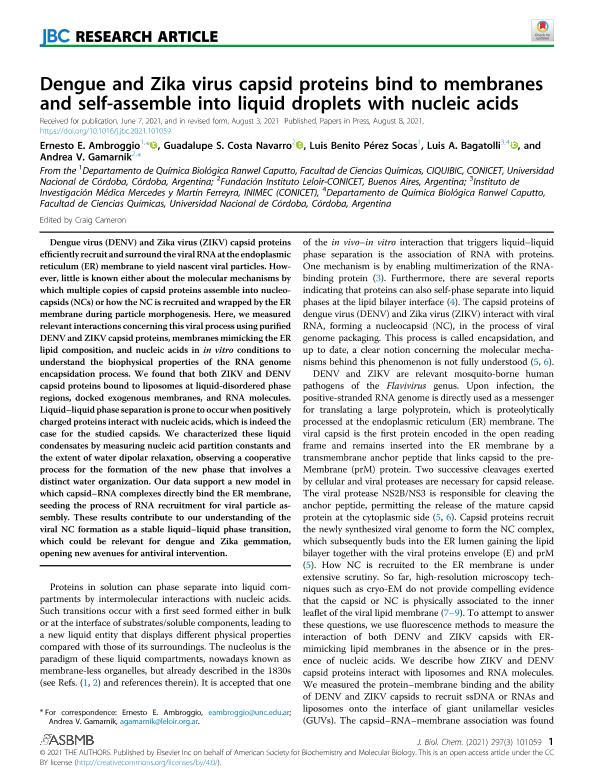Mostrar el registro sencillo del ítem
dc.contributor.author
Ambroggio, Ernesto Esteban

dc.contributor.author
Costa Navarro, Guadalupe Soledad

dc.contributor.author
Pérez Socas, Luis Benito

dc.contributor.author
Bagatolli, Luis Alberto

dc.contributor.author
Gamarnik, Andrea Vanesa

dc.date.available
2023-01-03T12:26:46Z
dc.date.issued
2021-09
dc.identifier.citation
Ambroggio, Ernesto Esteban; Costa Navarro, Guadalupe Soledad; Pérez Socas, Luis Benito; Bagatolli, Luis Alberto; Gamarnik, Andrea Vanesa; Dengue and Zika virus capsid proteins bind to membranes and self-assemble into liquid droplets with nucleic acids; American Society for Biochemistry and Molecular Biology; Journal of Biological Chemistry (online); 297; 3; 9-2021; 1-11
dc.identifier.issn
0021-9258
dc.identifier.uri
http://hdl.handle.net/11336/183103
dc.description.abstract
Dengue virus (DENV) and Zika virus (ZIKV) capsid proteins efficiently recruit and surround the viral RNA at the endoplasmic reticulum (ER) membrane to yield nascent viral particles. However, little is known either about the molecular mechanisms by which multiple copies of capsid proteins assemble into nucleocapsids (NCs) or how the NC is recruited and wrapped by the ER membrane during particle morphogenesis. Here, we measured relevant interactions concerning this viral process using purified DENV and ZIKV capsid proteins, membranes mimicking the ER lipid composition, and nucleic acids in in vitro conditions to understand the biophysical properties of the RNA genome encapsidation process. We found that both ZIKV and DENV capsid proteins bound to liposomes at liquid-disordered phase regions, docked exogenous membranes, and RNA molecules. Liquid–liquid phase separation is prone to occur when positively charged proteins interact with nucleic acids, which is indeed the case for the studied capsids. We characterized these liquid condensates by measuring nucleic acid partition constants and the extent of water dipolar relaxation, observing a cooperative process for the formation of the new phase that involves a distinct water organization. Our data support a new model in which capsid–RNA complexes directly bind the ER membrane, seeding the process of RNA recruitment for viral particle assembly. These results contribute to our understanding of the viral NC formation as a stable liquid–liquid phase transition, which could be relevant for dengue and Zika gemmation, opening new avenues for antiviral intervention.
dc.format
application/pdf
dc.language.iso
eng
dc.publisher
American Society for Biochemistry and Molecular Biology

dc.rights
info:eu-repo/semantics/openAccess
dc.rights.uri
https://creativecommons.org/licenses/by/2.5/ar/
dc.subject
Zika and dengue
dc.subject
Capsid-RNA interaction
dc.subject
Capsid-membrane interaction
dc.subject
Flavivirus
dc.subject
Liquid-liquid phase separation
dc.subject.classification
Biofísica

dc.subject.classification
Ciencias Biológicas

dc.subject.classification
CIENCIAS NATURALES Y EXACTAS

dc.title
Dengue and Zika virus capsid proteins bind to membranes and self-assemble into liquid droplets with nucleic acids
dc.type
info:eu-repo/semantics/article
dc.type
info:ar-repo/semantics/artículo
dc.type
info:eu-repo/semantics/publishedVersion
dc.date.updated
2022-08-08T15:42:47Z
dc.identifier.eissn
1083-351X
dc.journal.volume
297
dc.journal.number
3
dc.journal.pagination
1-11
dc.journal.pais
Estados Unidos

dc.journal.ciudad
Bethesda, Maryland
dc.description.fil
Fil: Ambroggio, Ernesto Esteban. Consejo Nacional de Investigaciones Científicas y Técnicas. Centro Científico Tecnológico Conicet - Córdoba. Centro de Investigaciones en Química Biológica de Córdoba. Universidad Nacional de Córdoba. Facultad de Ciencias Químicas. Centro de Investigaciones en Química Biológica de Córdoba; Argentina
dc.description.fil
Fil: Costa Navarro, Guadalupe Soledad. Consejo Nacional de Investigaciones Científicas y Técnicas. Oficina de Coordinación Administrativa Parque Centenario. Instituto de Investigaciones Bioquímicas de Buenos Aires. Fundación Instituto Leloir. Instituto de Investigaciones Bioquímicas de Buenos Aires; Argentina
dc.description.fil
Fil: Pérez Socas, Luis Benito. Consejo Nacional de Investigaciones Científicas y Técnicas. Centro Científico Tecnológico Conicet - Córdoba. Centro de Investigaciones en Química Biológica de Córdoba. Universidad Nacional de Córdoba. Facultad de Ciencias Químicas. Centro de Investigaciones en Química Biológica de Córdoba; Argentina
dc.description.fil
Fil: Bagatolli, Luis Alberto. Universidad Nacional de Córdoba. Facultad de Ciencias Químicas. Departamento de Química Biológica; Argentina. Consejo Nacional de Investigaciones Científicas y Técnicas. Centro Científico Tecnológico Conicet - Córdoba. Instituto de Investigación Médica Mercedes y Martín Ferreyra. Universidad Nacional de Córdoba. Instituto de Investigación Médica Mercedes y Martín Ferreyra; Argentina
dc.description.fil
Fil: Gamarnik, Andrea Vanesa. Consejo Nacional de Investigaciones Científicas y Técnicas. Oficina de Coordinación Administrativa Parque Centenario. Instituto de Investigaciones Bioquímicas de Buenos Aires. Fundación Instituto Leloir. Instituto de Investigaciones Bioquímicas de Buenos Aires; Argentina
dc.journal.title
Journal of Biological Chemistry (online)

dc.relation.alternativeid
info:eu-repo/semantics/altIdentifier/url/https://www.sciencedirect.com/science/article/pii/S0021925821008619
dc.relation.alternativeid
info:eu-repo/semantics/altIdentifier/doi/http://dx.doi.org/10.1016/j.jbc.2021.101059
Archivos asociados
